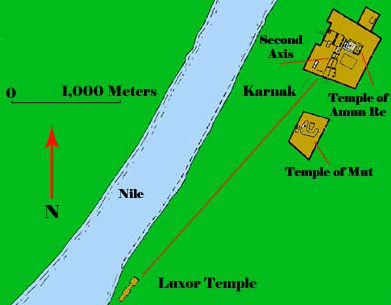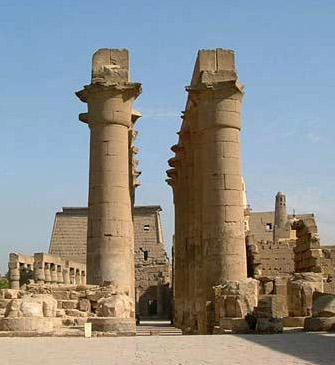The Beautiful Feast of the Opet (The Opet Festival)
Part I: An Introduction
by John Watson

We refer to the Opet Festival as one of the most important reoccurring event of its nature during ancient Egyptian history, even though we know very little about it, or for that matter, if it even really existed prior to the New Kingdom. In reality though, its prominence is much elevated in our minds by the grandeur of the surviving temples where it took place, other perhaps equally grand, or at least important temples existed in Egypt that are now gone, such as those at Memphis and Heliopolis (and many others). We know very little about the festivals that might have taken place in those areas. Certainly, the King's Sed-Festival, an event also of regeneration, appears to have been a grand event, particularly during earlier periods. Nevertheless, the Opet festival became one of the most celebrated festivals from the New Kingdom onward.

During ancient Egypt's New Kingdom Period, the Opet Festival, was one of the most important ceremonies, as well as one of the longest lasting events of its kind. At that time, the reigning monarch was identified with the royal ka, divine kingship was reborn and the individual king's right to rule was reconfirmed. At the climax of the festival, Amun-Re's powers were transferred to the king. Beyond its significance to kingship, the festival also secured the regeneration of the Creator, Amun of Luxor Temple, the rebirth of Amun-Re of Karnak (the Temple of Amun-Re) and the recreation of the cosmos. Not surprisingly therefore, it witnessed the personal involvement of the pharaoh.

The ancient priests of Egypt believed that in the course of the year, the gods grew weary as the agricultural cycle ran its course. They, along with the world they created, required an input of fresh energy. To do this, they needed to draw from outside the created world in order to tap the pure, uncontrolled power of the boundless chaos surrounding the cosmos, but opening that door to the uncreated was no simple matter, laden with danger. However, if the ceremony was carried out properly, it was thought to result in rebirth and recreation for both king and gods.
We know that from as early as the Old Kingdom, the ancient Egyptians used three calendars for various purposes, including lunar, solar/sidereal and civil ones. Prior to the unification of Egypt, during prehistoric times, the lunar calendar had twelve months and 354 days. It was therefore unsynchronized with the cycle of solar seasons, which repeated approximately every 365 1/4 days. Later, the lunar calendar was adjusted by adding in a thirteenth lunar month once every three years or so. This solar corrected lunar calendar was the one used to determine the dates of religious festivals during the New Kingdom.

Detail the Hatshpsut's Chapel now located in the Open Air Museum at Karnak, depicting the procession
In accordance with that calendar, the Opet Festival apparently began on the fifteenth or nineteenth day of the second month of the first season, called Inundation. At first, it lasted only eleven days, but it was elaborately extended over time to a length of twenty-four or even twenty-seven days.

Even though the rough solar adjusted lunar calendar was not completely accurate, the date of the Opet Festival always fell somewhere near the beginning of the Nile's three-month flood season. This also meant that the common people of Egypt, who mostly worked in the fields, were free to actively and even boisterously participate in the festival.
Indeed, beyond the religious significance of the event, it was a time of gaiety. The ancient Egyptian population enjoyed the generosity of the gods during these festivals. During one Opet festival in the 12th century BC, it is recorded that temple officials distributed 11,341 loaves of bread and 385 jars of beer to the citizens.

Karnak has been called the largest religious complex still in existence. Part of that construct was specifically oriented to accommodate the Festival of the Opet, and the nearby Luxor Temple seems to have been oriented specifically for that ceremony. Hence, to understand these two greatest of Egypt's remaining temples, one must have an understanding of the Opet Festival, that is prominently depicted on the walls of both.
The Opet Festival that was celebrated in ancient Thebes (modern Luxor), more formally perhaps known as "The Beautiful Feast of Opet", linked the temple complex of Karnak with that of Luxor Temple. In the Temple of Amun-Re, the primary one in the Karnak complex, there are two axis. The primary one is oriented east-west, and therefore parallel to the course of the sun, while the secondary axis is aligned parallel to the Nile and therefore to Luxor Temple to the south. The latter axis, we believe, must have been constructed with the Opet Festival in mind, for Luxor Temple's architectural history, as far as we know, was oriented back towards Karnak.

Though at times sketchy, we do have considerable pictorial and textual records describing the Opet Festival procession and even some of its events. Most of this originates from the reigns of Hatshepsut, Amenhotep III and Tutankhamun, with architectural evidence particularly from the reign of Ramesses II. Hatshepsut, as far as we know, was the first king to depict the Opet Festival, and it is not absolutely certain that it was held prior to her reign, although we presume that it was. However, she seems almost certainly to have actively developed, or at least elaborated, the Opet Festival to her own benefit. This is not very surprising. Though perhaps not the first, female Kings of Egypt were rare, and there is much evidence to suggest that she felt the need to prove her divine right to the throne considerably more than most of her male counterparts.
Major events associated with the Opet Festival procession are schematically represented on the walls of the Colonnade in Luxor Temple, but fragmentary scenes found elsewhere suggest that the real sequence of the festival may have been somewhat different.

At Karnak, the people doubtless watched the high priests disappear into the temple. Inside, the priests would have bathed the image of the god and dressed him in colorful linen and adorned him with jewelry from the temple treasury, adorning him in magnificent necklaces, bracelets, scepters, amulets and trinkets of gold or silver encrusted with lapis lazuli, enamel, glass and semi-precious gems. The priests then enclosed the god in a shrine and afterwards placed the shrine on top of a ceremonial barque or boat, often supported by poles so that it could be easily carried.


Thus began the Grand Opet Festival, winding its way either by the Nile or by the land route from Karnak to Luxor Temple.
The Beautiful Feast of the Opet (The Opet Festival) Part II: The Path to Renewal
Last Updated: December 25th, 2011

